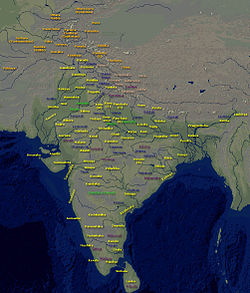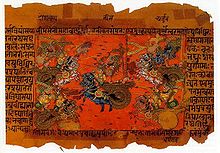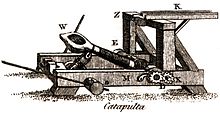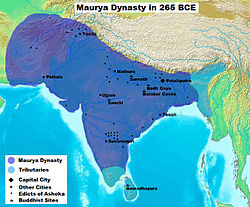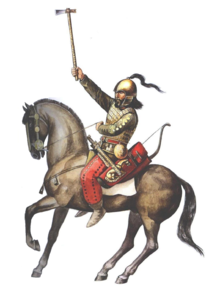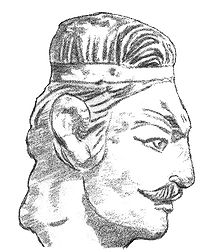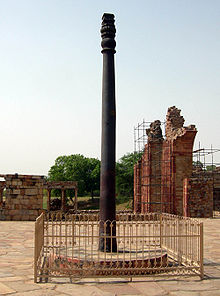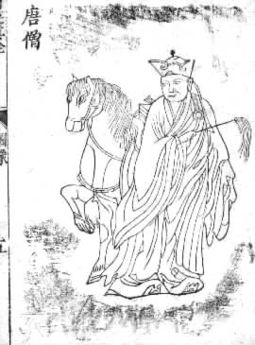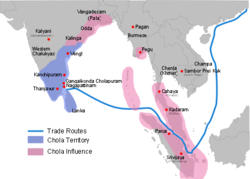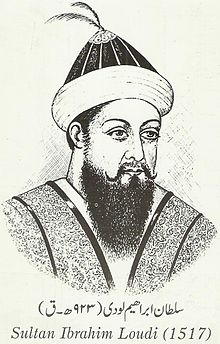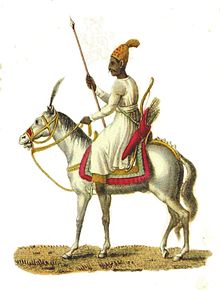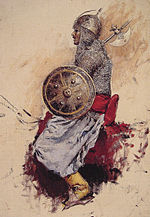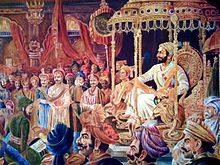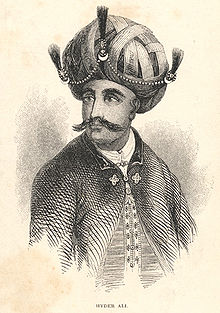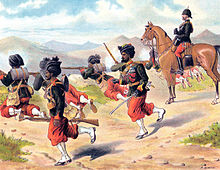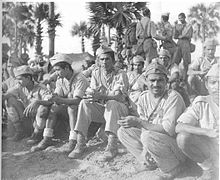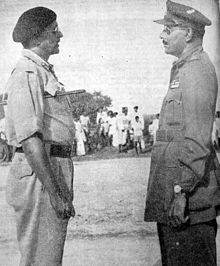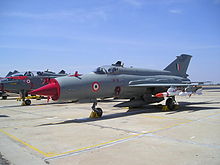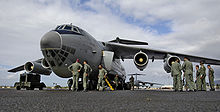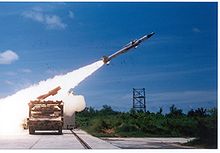- Military history of India
-
History of South Asia and India Stone age (7000–1300 BCE)- Mehrgarh Culture (7000–3300 BCE)
- Indus Valley Civilization (3300–1700 BCE)
- Early Harappan Culture (3300–2600 BCE)
- Mature Harappan Culture (2600–1900 BCE)
- Late Harappan Culture (1700–1300 BCE)
- Ochre Coloured Pottery culture (from 2000 BCE)
- Swat culture (1600–500 BCE)
Iron age (1200–26 BCE)- Vedic Civilization (2000–500 BCE)
- Black and Red ware culture (1300–1000 BCE)
- Painted Grey Ware culture (1200–600 BCE)
- Northern Black Polished Ware (700–200 BCE)
- Maha Janapadas (700–300 BCE)
- Magadha Empire (684–424 BCE)
- Nanda Empire (424–321 BCE)
- Chera Empire (300 BCE–1200 CE)
- Chola Empire (300 BCE–1279 CE)
- Pandyan Empire (300 BCE–1345 CE)
- Maurya Empire (321–184 BCE)
- Pallava Empire (250 BCE–800 CE)
- Sunga Empire (185–73 BCE)
- Kanva Empire (75–26 BCE)
- Maha-Megha-Vahana Empire (250s BCE–400s CE)
- Satavahana Empire (230–220 BCE)
- Kuninda Kingdom (200s BCE–300s CE)
- Indo-Scythian Kingdom (200 BCE–400 CE)
- Indo-Greek Kingdom (180 BCE–10 CE)
Classical period (1–1279 CE)- Indo-Parthian Kingdom (21–130s CE)
- Western Satrap Empire (35–405 CE)
- Kushan Empire (60–240 CE)
- Indo-Sassanid Kingdom (230–360 CE)
- Vakataka Empire (250s–500s CE)
- Kalabhras Empire (250–600 CE)
- Gupta Empire (280–550 CE)
- Kadamba Empire (345–525 CE)
- Western Ganga Kingdom (350–1000 CE)
- Kamarupa Kingdom (350–1100 CE)
- Vishnukundina Empire (420–624 CE)
- Maitraka Empire (475–767 CE)
- Huna Kingdom (475–576 CE)
- Rai Kingdom (489–632 CE)
- Chalukya Empire (543–753 CE)
- Shahi Empire (500s–1026 CE)
- Maukhari Empire (550s–700s CE)
- Harsha Empire (590–647 CE)
- Eastern Chalukya Kingdom (624–1075 CE)
- Gurjara Pratihara Empire (650–1036 CE)
- Pala Empire (750–1174 CE)
- Rashtrakuta Empire (753–982 CE)
- Paramara Kingdom (800–1327 CE)
- Yadava Empire (850–1334 CE)
- Solanki Kingdom (942–1244 CE)
- Western Chalukya Empire (973–1189 CE)
- Hoysala Empire (1040–1346 CE)
- Sena Empire (1070–1230 CE)
- Eastern Ganga Empire (1078–1434 CE)
- Kakatiya Kingdom (1083–1323 CE)
- Kalachuri Empire (1130–1184 CE)
Late medieval age (1206–1596 CE)- Delhi Sultanate (1206–1526 CE)
- Ahom Kingdom (1228–1826 CE)
- Reddy Kingdom (1325–1448 CE)
- Vijayanagara Empire (1336–1646 CE)
- Gajapati Kingdom (1434–1541 CE)
- Deccan Sultanates (1490–1596 CE)
Early modern period (1526–1858 CE)- Mughal Empire (1526–1858 CE)
- Maratha Empire (1674–1818 CE)
- Durrani Empire (1747–1823 CE)
- Sikh Empire (1799–1849 CE)
Regional states (1102–1947 CE)- Zamorin Kingdom (1102–1766 CE)
- Deva Kingdom (1200s–1300s CE)
- Chitradurga Kingdom (1300–1779 CE)
- Garhwal Kingdom (1358–1803 CE)
- Mysore Kingdom (1399–1947 CE)
- Keladi Kingdom (1499–1763 CE)
- Koch Kingdom (1515–1947 CE)
- Thondaiman Kingdom (1650–1948 CE)
- Madurai Kingdom (1559–1736 CE)
- Thanjavur Kingdom (1572–1918 CE)
- Marava Kingdom (1600–1750 CE)
- Sikh Confederacy (1707–1799 CE)
- Travancore Kingdom (1729–1947 CE)
Colonial period (1505–1961 CE)- Portuguese India (1510–1961 CE)
- Dutch India (1605–1825 CE)
- Danish India (1620–1869 CE)
- French India (1759–1954 CE)
- Company Raj (1757–1858 CE)
- British Raj (1858–1947 CE)
- Partition of India (1947 CE)
Kingdoms of Sri Lanka (543 BCE–1948 CE)- Kingdom of Tambapanni (543–505 BCE)
- Kingdom of Upatissa Nuwara (505–377 BCE)
- Kingdom of Anuradhapura (377 BCE–1017 CE)
- Kingdom of Ruhuna (200 CE)
- Polonnaruwa Kingdom (300–1310 CE)
- Kingdom of Dambadeniya (1220–1272 CE)
- Kingdom of Yapahuwa (1272–1293 CE)
- Kingdom of Kurunegala (1293–1341 CE)
- Kingdom of Gampola (1341–1347 CE)
- Kingdom of Raigama (1347–1415 CE)
- Kingdom of Kotte (1412–1597 CE)
- Kingdom of Sitawaka (1521–1594 CE)
- Kingdom of Kandy (1469–1815 CE)
- Portuguese Ceylon (1505–1658 CE)
- Dutch Ceylon (1656–1796 CE)
- British Ceylon (1815–1948 CE)
Nation histories- Afghanistan
- Bangladesh
- Bhutan
- India
- Maldives
- Nepal
- Pakistan
Regional histories- Assam
- Bihar
- Balochistan
- Bengal
- Himachal Pradesh
- Maharashtra
- Uttar Pradesh
- Pakistani Regions
- Punjab
- NWFP
- Orissa
- Sindh
- South India
- Tibet
The military history of India dates back several millennia. The first reference to armies is found in the Vedas and the epics Ramayana and Mahabaratha. From the ancient period through to the 19th century, a succession of powerful dynasties rose and fell in India as smaller rulers also struggled for power through war. The British colonised India during the 19th century through a combination of outright conquest and intimidation.
The predecessors to the modern Army of India were the sepoy battalions, native cavalry, irregular horse and Indian sapper and miner companies raised by the three British presidencies. The Army of India was raised under the British Raj in the 19th century by taking the erstwhile presidency armies, merging them, and bringing them under the Crown. The British Indian Army fought in both World Wars.
The armed forces succeeded the military of British India following India's independence in 1947. After World War II, many of the wartime troops were discharged and units disbanded. The reduced armed forces were partitioned between India and Pakistan. The Indian armed forces fought in all three wars against Pakistan and a war with the People's Republic of China. India also fought in the Kargil War with Pakistan in 1999, the highest altitude mountain warfare in history. The Indian Armed Forces have participated in several United Nations peacekeeping operations and are presently the second largest contributor of troops to the peacekeeping force.
Vedic period
The Rigvedic tribes of Indo-Aryans were led by their tribal chieftains (raja) and engaged in wars with each other and other tribes. They used bronze weapons and horse-drawn spoke-wheeled chariots described prominently in the Rigveda. The main share from the booty obtained during cattle raids and battles went to the chief of the tribe. The warriors belonged to the Kshatriya varna.
The Vedas and other associated texts dating to the post-Rigvedic (Iron Age) Vedic period (ca. 1100–500 BC) contain the earliest written references to armies in India. The earliest known application of war elephants dates to this period; the animals are mentioned in several Vedic Sanskrit hymns.[1]
The two great epics of India, the Ramayana and the Mahabharata, center on conflicts between the emerging Mahajanapadas and refer to military formations, theories of warfare and esoteric weaponry. They discuss standing armies and the use of chariots, war elephants and even flying machines in wars. The Ramayana describes the fortifications of Ayodhya in great detail. The Mahabharata describes various military techniques like Chakravyuha used in the Kurukshetra War.
The Magadha empire
Shishunaga dynasty
The expansionist King Bimbisara conquered Anga in what is now West Bengal and strengthened the military of Magadh's capital, Rajagriha. Ajatashatru built a new fort at Pataliputra, Magadh's new capital, to launch an attack on Licchavis across the Ganges River. Jain texts tell that he used two new weapons, a catapult and a covered chariot with swinging mace that has been compared[by whom?] to modern tanks.
Nanda dynasty
Mahapadma Nanda defeated Ikshvakus, Panchalas, Kasis, Harhayas, Kalingas, Asmakas, Kurus, Maithilas, Surasenas, and Vitihotras and assumed the title "the destroyer of the kshathriyas". At the time of Dhana Nanda, the Nandas had an army consisting of 80,000 cavalry, 20,000 infantry, 8,000 armed chariots, and 6,000 war elephants.
Maurya Dynasty
According to Megasthenes, who served as an ambassador from the Seleucid Empire, Chandragupta Maurya built an army consisting of 30,000 cavalry, 9,000 war elephants, and 600,000 infantry; modern historians[who?] believe these numbers exaggerated. Chandragupta conquered all of northern India, establishing an empire from the Arabian Sea to the Bay of Bengal. He then defeated the Macedonians and Seleucus Nicator to conquer the regions to the east of the Indus river. He then turned south, taking over much of what is now Central India. His military was administered by six chairs, one for each of the four arms of the army (infantry, cavalry, elephants, and chariots), one chair for the navy, and one for logistics and supply.
Infantry at this time was most commonly armed with a longbow made of bamboo and a single- or double-handed broadsword probably similar to the khanda. Other foot soldiers could be armed with a large animal hide tower shield and a spear or javelins. Cavalry carried spears. Elephants were mounted, usually bareback (rarely with a howdah at this time, as it is a Greek invention), by archers or javelin throwers, with a mahout around the animal's neck. Chariots by this time were in definite decline, but remained in the army due to their prestige.
In 185 BC, the last Mauryan king was assassinated by Pushyamitra Shunga, the Commander-in-Chief of the Mauryan armed forces.
Early Middle Kingdoms (the golden age)
Classical Indian texts on archery in particular and martial arts in general are known as Dhanurveda. Several classics of the genre date from this period.
Satavahana dynasty
According to some interpretations of the Puranas, the Satavahana family belonged to the Andhra-jati ("tribe") and was the first Deccanese dynasty to build an empire in daksinapatha (southern region). The Satavahanas (also called Andhra and Shalivahan) rose to power in modern Maharashtra around 200 B.C. and remained in power for about 400 years. Almost the whole of present day Maharashtra, Madhya Pradesh, Chattisgarh, Orissa, Goa, Karnataka, and Andhra Pradesh came under Satavahana rule. Their capital was Paithan, then called Pratishthan.
Simuka, the dynasty's founder, conquered Maharashtra, Malwa and part of Madhya Pradesh. His successor and brother Kanha (or Krishna) further extended his kingdom to the west and the south. He was succeeded by Satakarni I, who defeated the Sunga dynasty of North India. His successor, Gautamiputra Satakarni, defeated the invading Sakas (Scythians), Yavanas (Greeks) and Pahlavas (Parthians), as well as the Western Kshatrapas ruler Nahapana. His empire extended up to Banavasi in the south, and included Maharashtra, Konkan, Saurashtra, Malwa, west Rajasthan and Vidharbha. Later Satavahana rulers lost some of these territories. Satavahana power revived briefly under Yajna Sri Satakarni but declined after his death.
Kushan empire
Vima Takto, using the name "Soter Megas" (Great Saviour), conquered Gandhara and northern India in 68 AD. The Kushan warriors were assimilated into Indian society as Kshatriyas. Following Yuezhi's style, most Kushan nobles fought on horseback supported by cataphracts, which were the backbone of the Kushan army and whose use increased with time. Coins depicting Kujula, Vima Takto, Vima Kadphises and Kanishka show the king unarmoured or armoured more lightly than later Kushan kings. On many coins Kanishka appears to have a bow, but this interpretation is debatable.[citation needed] Some Buddhist texts indicate the use of Indian influences like elephants leading the attacks and the use of chariots. Elephants first appeared on the coins of Vima Kadphises and probably went on to become the mount of the kings. The elephants are depicted with towers and a covering; it is unclear whether these were armour or just padding. Buddhist texts mention that the infantry were used to support these elephants. The historian Nikonorov suggests that the elephants used were provided by the Satraps. Greeks, various mountain tribes, Sacas from northern India and Iranian mercenaries also fought in the Kushan army.
Gupta dynasty
Siva-Dhanur-veda discusses the military of the Gupta Empire. The Guptas relied heavily on armoured war elephants; horses were used little if at all. The use of chariots had declined heavily by the time of the Guptas, as they had not proved very useful against the Macedonians, Scythians, and other invaders. Guptas utilised heavy cavalry clad in mail armour and equipped with maces and lances, who would have used shock action to break the enemy line. They also employed on infantry archers. Their longbow was composed of bamboo or metal and fired a long bamboo cane arrow with a metal head; iron shafts were used against armoured elephants. They also sometimes used fire arrows. Archers were frequently protected by infantry equipped with shields, javelins, and longswords. The Guptas also maintained a navy, allowing them to control regional waters.
 Coin of Rudrasimha III, the last Western Satrap ruler.
Coin of Rudrasimha III, the last Western Satrap ruler.
Samudragupta seized the kingdoms of Shichchhatra and Padmavati early in his reign. Later, he took the Kota kingdom and attacked the tribes in Malvas, the Yaudheyas, the Arjunayanas, the Maduras and the Abhiras. By his death in 380, he had conquered over twenty kingdoms. Chandragupta II defeated his rival, Rudrasimha III, by 395 and defeated the Saka Western Kshatrapas of Malwa, Gujarat and Saurashtra in a campaign lasting until 409. Chandragupta II also crushed the Bengal (Vanga) chiefdoms. Skandagupta defeated Pushyamitra and repelled the attack of Hephthalites or "White Huns" around 455, but the expense of the wars drained the empire's resources and contributed to its decline.
Late Middle Kingdoms (the classical age)
Harsha's empire
Emperor Harshavardhana (606–648) ruled northern India for over forty years. His father, a king of Thanesar, had gained prominence by successful wars against the Huns. Harsha had plans to conquer the whole of India, and carried on wars for thirty years with considerable success. By 612 he had built up a vast army with which he conquered nearly all North India up to the Narmada river. In 620 he invaded the Deccan Plateau but was repelled by Pulakesi II.
The Chalukyas and Pallavas
In South India, the Chalukyas and the Pallavas gained prominence. The Chalukya king Pulakesi II's expansionism started with minor campaigns against the Alupas, Gangas and others. He defeated the Pallava king Mahendravarman and conquered the Cheras and the Pandyas. His greatest military success, the defeat of Harshavardhana, depleted his treasury, forcing him to end his expansionist campaigns.
The Pallava king Narasimhavarman vowed to avenge Mahendravarman's defeat by Pulakesi II. He invaded Vatapi with an army headed by his general Paranjothi. He defeated the Chalukyas, killing Pulakesi II in 642. Clashes between the Chalukyas and the Pallavas continued for a century, until the Chalukya king Vikramaditya II won a decisive victory against the Pallavas in 740. The Rashtrakutas overthrew the Chalukya empire in 750. During the 970s, Tailapa II overthrew the Rashtrakutas and recovered most of the Chalukya empire, except for Gujarat. The Chalukyas of this period are known as the Kalyani Chalukyas, as Kalyani was their capital. They clashed intermittently with the Cholas.
The Chola empire
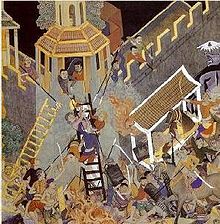 Depiction of the siege of Kedah by Beemasenan's naval infantry.
Depiction of the siege of Kedah by Beemasenan's naval infantry.
The Cholas were the first rulers of the Indian subcontinent to maintain a navy and use it to expand their dominion overseas. Vijayalaya Chola defeated the Pallavas and captured Thanjavur. In the early 10th century the Chola king Parantaka I defeated the Pandyan king Maravarman Rajasimha II and invdaded Sri Lanka. The Rashtrakuta ruler Krishna III defeated and killed Parantaka I's son Rajaditya in about 949.
Uttama Chola reigned 970-85. Inscriptions tell that at least from his time, Chola warriors wore waist coats of armour. Hence, one regiment was called Niyayam-Uttama-Chola-tterinda-andalakattalar. Paluvettaraiyar Maravan Kandanar served as a general under Uttama and his father, Sundara.
Rajaraja Chola began his military career with the conquest of the Cheras in the Kandalur War. He captured Pandya Amara Bhujanga, Vilinam, and a part of Sri Lanka. In the 14th year of his reign (998–999) he conquered the Gangas of Mysore, the Nolambas of Bellary and Eastern Mysore, Tadigaipadi, Vengi, Coorg, the Pandyas and the Chalukyas of the Deccan. During the next three years, he subdued Quilon and the northern kingdom of Kalinga with the help of his son Rajendra Chola I. Rajendra later completed the conquest of Sri Lanka, crossed the Ganges, and marched across Kalinga to Bengal. He sent out a great naval expedition that occupied parts of Burma (Myanmar), Java, Malaya, and Sumatra. The Cholas were brought down by the Hoysalas from the west and Pandyas from the south.
The Pratiharas, Palas and Rashtrakutas
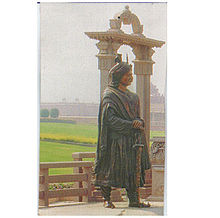 A statue of the Pratihara ruler Samraat Mihir Bhoj.
A statue of the Pratihara ruler Samraat Mihir Bhoj.
In middle of 9th century, the Palas under Devapala attacked the Pratiharas. Led by Bhoj, the Pratiharas and their allies defeated Narayan Pala.
There were many battles between the Pratiharas under Bhoj and the Rashtrakutas under Krishna II with mixed results. When the Rashtrakuta king Indra III attacked Kanauj, Mahipala, Bhoj's successor, fled; he later returned.
Al-Masudi wrote that in 915, during Mahipala's rule, the Pratiharas were at war with the Muslims in the west and the Rashtrakutas in the south, and that the Pratiharas had four armies of about 800,000 men each.
The Medieval era
Delhi Sultanate
The Delhi Sultanate, under the Khilji dynasty, repelled several invasions by the Mongol Empire. Zafar Khan, a general serving Alauddin Khilji, defeated the Mongols near Jalandhar in 1297. In 1299, Zafar Khan fought back a Mongol army of 200,000 soldiers but was killed in the process. Its last sultan, Ibrahim Lodi, died fighting the forces of Babur in the first battle of Panipat in 1526, ending the sultanate and paving the way for the foundation of the Mughal Empire.
The Rajputs
After Babur's victory over Ibrahim Lodi, the Mewar ruler Rana Sanga led a combined Rajput army of 20,000 intending to defeat Babur and capture Delhi. The Mughals had superior artillery, which prevailed against the Rajput cavalry. A Tomar general betrayed Rana Sanga, resulting in his defeat by Babur at the Battle of Khanua (16 March 1527). During the reign Rana Sanga's son Rana Udai Singh II, Babur's grandson Akbar conquered Chittor, the capital of Mewar.
In the Battle of Haldighati (21 June 1576) between Akbar and Rana Pratap Singh, the Mughal army of 80,000 was headed by a Rajput, Raja Man Singh, and Akbar's son Salim. The Rajput army's strength was 20,000. After a four-hour battle in which most of his soldiers were either killed or captured, Rana Pratap escaped with the help of his estranged brother Sakta Singh. His legendary horse Chetak was killed in the battle. Later, Rana Pratap organized a small army of Bhil tribals funded by a businessman called Bhamashah and started a guerrilla war against Akbar. He retook large parts of Mewar but could not retake Chittor.
Muzaffarid dynasty
Sultan Muzaffar Shah I, the Governor of Gujarat, established the Muzaffarid dynasty in 1391. It expanded rapidly and peaked under Sultan Mahmud I, who lost the Battle of Diu to the Portuguese in 1509.
Calicut
Ruled by the Zamorin, the small Hindu Nair kingdom of Calicut (Malabar) welcomed the Portuguese in 1498 as traders but then fought several naval wars with Portugal in the 1500s. The office of Muslim naval chief in Calicut was known as the Kunhali Marakkar.
Vijayanagara Empire
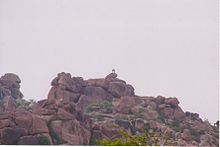 A sentry post, Vijayanagar area
A sentry post, Vijayanagar area
In 1509, the Bahamani Sultan declared war against the Vijayanagara Empire. His large coalition army was defeated by Krishnadevaraya in a battle in which the Sultan was wounded. In 1510, Krishnadevaraya launched a counteroffensive against the Sultan at Kovelaconda; Yusuf Adil Shahi of Bijapur died in the battle. In 1512, Krishnadevaraya captured Raichur and Gulbarga after defeating Barid-i-Mamalik, the titular head of the Bahmani Sultanate, who escaped to Bidar. Later, Bidar also fell to Krishnadevaraya, who restored the Bahmani Sultan to his throne under the terms of their peace treaty.
Between 1512 and 1514, Krishnadevaraya subjugated the Palaigar of Ummattur, who had rebelled against his brother. During this campaign, the Gajapati of Orissa attacked Vijayanagara and occupied two northeast provinces, Udayagiri and Kondavidu. Krishnadevaraya recaptured these lands between 1513 and 1518.
On 26 January 1565, the neighboring kingdoms of Ahmednagar, Berar, Bidar, Bijapur and Golconda came together to defeat the Vijayanagar decisively in the Battle of Talikota. The surviving Vijaynagar forces fled with a large treasury to re-establish their headquarters at Vellore Fort in Tamil Nadu and Chandragiri (Andhra Pradesh) near Tirupathi. It would be here that the British would seek a land grant to establish the English East India Company Fort St. George in Madras.
Later, the Vijayanagara's southern Telugu governors, in present day Tamil Nadu, became independent. They became the Gingee Nayaks in Gingee Fort, the Tanjore Nayaks, and the Nayaks of Madurai.
Mughal Empire
See also: Mughal–Safavid War (1649–1653) Sikh and Maratha states gained territory after the Mughal empire's decline. Map showing territories in 1700 and 1792
Sikh and Maratha states gained territory after the Mughal empire's decline. Map showing territories in 1700 and 1792
The Mughal Empire began in 1526 with the overthrow of Ibrahim Lodi and encompassed most of South Asia by the late 17th and early 18th centuries. Allied with the Maharaja, it extended from Bengal in the east to Balochistan in the west, Kashmir in the north to the Kaveri basin in the south,[3] a territory of over 4 million km2 at its height. Its population at that time has been estimated at between 110 and 130 million.[4] It ended in the mid-19th century.
The "classic period" of the Empire started in 1556 with the accession of Akbar the Great and ended with the death of Emperor Aurangzeb in 1707,[5][6] although the dynasty continued for another 150 years. During this period, the Empire was marked by centralized administration and active culture. Following 1725 the empire declined rapidly, weakened by wars of succession; famine and local revolts fueled by it; the growth of religious intolerance; the rise of the Maratha, Durrani, and Sikh empires; and finally British colonialism. The last Mughal emperor, Bahadur Shah II, whose rule was restricted to the city of Delhi, was imprisoned and exiled by the British after the Indian Rebellion of 1857.
The Maratha Empire
The Maratha Empire of India, also called the Maratha Confederacy, was founded by Chatrapati Shivaji in 1674, when he carved an independent Maratha zone around Pune, Maharshtra, from the Bijapur Sultanate. Shivaji established an effective civil and military administration. He made it a state policy never to desecrate a mosque or seize women after military raids. Though he was a Hindu, many Muslims served in his army. After a lifetime of conquest and guerrilla warfare with the Mughal emperor Aurangzeb, Shivaji died in 1680, leaving behind a kingdom of great but ill-defined extent. This was followed by a period of instability ending with Aurangzeb's death.
Shivaji was the second king in Indian history to maintain an active navy. Kanhoji Angre, the first Maratha naval chief under Shivaji's grandson Shahuji, controlled illegal entries into the Maratha Empire by Dutch, English and Portuguese commercial ships on the Western coast of India in the early 18th century. He remained undefeated until his death in 1729.
Although the descendants of Shivaji continued to rule, the office of the Peshwa, or the Prime Minister, became the focus of Maratha power and patronage. The Peshwas were the effective rulers of the Maratha state and oversaw the period of greatest Maratha expansion, brought to an end by the Maratha's defeat by an Afghan army at the Third Battle of Panipat in 1761. The Marathas recovered their position as the dominant power in India by 1772 until the last Peshwa, Baji Rao II, was defeated by the British in the Third Anglo-Maratha War.
Travancore
King Marthanda Varma inherited the small feudal state of Venad in 1723 and built it into Travancore, one of the most powerful kingdoms in southern India, with the help of the British East India Company. Marthanda Varma led the Travancore forces during the Travancore-Dutch War of 1739-46, which culinated in the Battle of Colachel. Marthanda Varma went on to conquer most of the petty principalities of the native Nair rulers who had allied with the Dutch against him.
During Dharma Raja's reign, Tipu Sultan invaded Travancore, but commander-in-chief Valia Kappithan led Travancore to victory despite being outnumbered. This attack led to Travancore joining the British against Tipu in the Third Battle of Carnatic. Pazhsi Raja, Velu Thampi Dalava and Paliath Achan, later leaders of Travancore, fought the British East India Company but lost. Travancore became a British ally in 1805 following a treaty between Colonel Charles Macaulay and Diwan Velu Tampi. It remained so until 1947 when it became part of the newly independent Union of India.
The principal military caste of Travancore was the Nairs.
Mysore
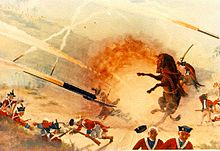 A painting showing Tipu Sultan's army fighting the British with rocket brigades, probably the first instance of rocket warfare in the Indian subcontinent[7]
A painting showing Tipu Sultan's army fighting the British with rocket brigades, probably the first instance of rocket warfare in the Indian subcontinent[7]
Hyder Ali, the de facto ruler of Mysore, was one of the first Indian rulers to resist the British, allying instead with France. He was one of the first Indian rulers to use rockets, employing them to defeat a top British unit.[8]
Hyder Ali's son Tipu Sultan was instructed by French military officers. Tipu fought in the First Anglo-Maratha War of 1775–1779. He defeated the Brathwaite on the banks of the Coleroon in February 1782 in the Second Mysore War. After his father's death in 1782, he sought alliances with the Marathas and the Mughals but was rebuffed. He turned to France instead. In 1789, he ignited the Third Mysore War by invading Travancore, a British protectorate, but was defeated when France failed to come to his aid due to the outbreak of the French Revolution. Later, Horatio Nelson ended Napoleon's ambitions for India at the Battle of the Nile. During the Fourth Mysore War of 1799, three armies—one from Bombay and two British, one of which was commanded by the future Duke of Wellington—marched into Mysore and besieged the capital, Srirangapatnam. On 4 May 1799, the armies broke through the defending walls. Tipu Sultan died of a gunshot wound near the gates of his fortress.
The Sikh Empire
Maharaja Ranjit Singh was a Sikh ruler of the sovereign country of Punjab and the Sikh Empire. His father Maha Singh led Sukerchakia, a misl within the Sikh Confederacy. Born in 1780 in Gujranwala, Ranjit Singh succeeded his father at the age of 12. He united the Sikh factions into the Sikh Empire and took the title "Maharaja" on 13 April 1801, to coincide with Baisakhi. Lahore was his capital from 1799. In 1802 he conquered Amritsar, a holy city of the Sikh religion. In 1822 Ranjit Singh hired European mercenaries for the first time to train a part of his troops. He modernized his army, creating a military force whose power delayed the eventual British colonization of Punjab. The result was a powerful and heavily armed state. The Battle of Jamrud in 1837 was a major setback for Ranjit Singh: his general Hari Singh Nalwa was killed, the Khyber Pass was established as the western limit of the Sikh Empire's influence.
Ranjit Singh died in 1839, and his empire crumbled under internal strife and poor governance by his heirs. On the east of his realm Gulab Singh extended Sikh authority in the Himalayas until stopped by the Qing Empire in the Sino-Sikh war (1841-1842). After the First Anglo-Sikh War (1845–46), Punjab effectively ceased to be an independent state. The British Empire annexed the Sikh Empire following the Second Anglo-Sikh War (1848–49).
Company rule
The British Indian Army was raised to guard the factories of the British East India Company. Following the fall of French Pondicherry in 1793, this was divided into Presidency armies of Bengal, Madras and Bombay in 1795. The Dutch trained the Nair Brigade, the military of Travancore.
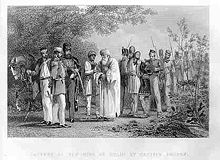 Capture of Bahadur Shah Zafar and his sons by William Hodson at Humayun's tomb on 20 September 1857
Capture of Bahadur Shah Zafar and his sons by William Hodson at Humayun's tomb on 20 September 1857
During the Sepoy Mutiny of 1857–58, some units of the Bengal Native Infantry and Cavalry revolted against the British East India Company. The rebels received less support than they had expected from members of the Bombay and Madras Armies. A number of atrocities took place, among them the Siege of Cawnpore. The mutiny ultimately failed because of lack of resources and coordination among the rebels. Reprisals by the victorious British Army, assisted by Sikh and Afghan regulars and irregulars, were ruthless.
The British Raj
Following the Sepoy Mutiny, British rule in India was reorganised under the British Raj, made up of areas directly administered by the United Kingdom and princely states under the paramountcy of the British Crown. Under terms of treaties with the Crown, these princely states were allowed some local autonomy in exchange for protection and representation in international affairs by the United Kingdom. The Raj included present-day India, Pakistan, and Bangladesh.
After 1857, the Presidency Armies were abolished in favour of a reconstituted British Indian Army under the control of the British Crown and the Viceroy. Many units were disbanded or reorganised, and new units of Sikhs, Gurkhas, and irregular horsemen were introduced. The majority of the Madras Native Infantry and Cavalry had their class compositions changed to North Indian tribes, considered more "martial" than the darker, shorter "thambis" who made up the majority of the Madras Presidency Army. Indian sepoys were banned from serving as officers or in the artillery corps. Recruiting focused more on Sikhs and Gurkhas, whom the British viewed as loyal. New caste-based and religion-based regiments were formed.
The British Indian Army consisted of members of all the major religious groups in India: Hindus, Sikhs, Christians, and Muslims. The number of Sikhs in the army grew steadily with time as British commanders came to believe they were more loyal and martial, an impression reinforced by their conduct during the Sepoy Mutiny. The Sikhs, for their part, aligned with the British to prevent a resurgence of Muslim rule; Sikhs had been persecuted under the Mughal Empire.
The Indian Air Force was established in 1932.
World War I
Main article: Indian Army during World War I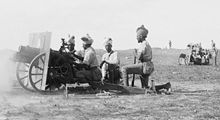 Indian Army gunners (probably 39th Battery) with 3.7 inch Mountain Howitzers, Jerusalem 1917
Indian Army gunners (probably 39th Battery) with 3.7 inch Mountain Howitzers, Jerusalem 1917
During World War I, over 800,000 volunteered for the army, and more than 400,000 volunteered for non-combat roles, compared with the pre-war annual recruitment of about 15,000 men.[9] The Army saw action on the Western Front within a month of the start of the war, at the First Battle of Ypres where Khudadad Khan became the first Indian to be awarded a Victoria Cross. After a year of front-line duty, sickness and casualties had reduced the Indian Corps to the point where it had to be withdrawn. Nearly 700,000 Indians fought the Turks in the Mesopotamian campaign. Indian formations were also sent to East Africa, Egypt, and Gallipoli.[10] Other divisions remained in India guarding the North-West Frontier and fulfilling internal security obligations.
One million Indian troops served abroad during the war. In total, 74,187 died,[11] and another 67,000 were wounded.[12] The roughly 90,000 soldiers who lost their lives fighting in World War I and the Afghan Wars are commemorated by the India Gate.
World War II
Main article: List of Indian divisions in World War IIIn 1939, the British Indian Army's strength was about 189,000, with about 3,000 British officers and 1,115 Indian officers. The army was expanded greatly to fight in World War II: by 1945, the strength of the Army had risen to about 2.5 million, with about 34,500 British officers and 15,740 Indian officers. The Army took part in campaigns in France, East Africa, North Africa, Syria, Tunisia, Malaya, Burma, Greece, Sicily and Italy. Particularly significant contributions came in the campaigns in Abyssinia and North Africa, against the Italians; at El Alamain and in Italy, against the Germans; and in the Burma Campaign against Japan. The army ultimately suffered 179,935 casualties: 24,338 killed, 64,354 wounded, 11,762 missing, and 79,481 taken prisoner.
During the war, Indian nationalists formed the Indian National Army to oppose the Raj. Led by the Nazi-trained Subhas Chandra Bose, it aligned with Axis powers, particularly Japan, who recognized Azad Hind as the government of India. The Japanese recruited many INA members from among the Indian soldiers who surrendered to Tomoyuki Yamashita at Singapore in February 1942. The INA participated in the Burma Campaign on the side of the Japanese and was defeated. INA fighters were largely acquitted during the INA trials that followed the war.
Republic of India
Major wars
The Republic of India has fought three wars and one major incursion battle with Pakistan and one border war with China.
First Indo-Pak war, 1947
Main article: Indo-Pakistani War of 1947Independent India, formed on 15 August 1947, has seen three wars with Pakistan (1947–48, 1965, 1971). The first war took place after Pakistani soldiers and armed tribesmen invaded the independent state of Kashmir. With Pakistani forces approaching the capital, Srinagar, Maharaja Hari Singh signed an agreement with India in which all Kashmiri lands were ceded to India. India sent troops in shortly after and took some of the territory they claimed as the new Indian state of Jammu and Kashmir from Pakistan. However, Pakistan maintained control of one-third of this territory, and the dispute continues.
Operation Polo, 1948
Main article: Operation PoloAfter the war with Pakistan, India turned its attention to the independent Hyderabad State. India perceived the nearby independent Muslim state and potential Pakistani ally as a threat. In a five-day operation, India invaded and annexed Hyderabad.
Invasion of Goa, 1961
Main article: Invasion of GoaIn 1961 tension rose between India and Portugal over the Portuguese-occupied territory of Goa, which India claimed for itself. After Portuguese police cracked down violently on a peaceful, unarmed demonstration for union with India, the Indian government decided to invade. A lopsided air, sea, and ground campaign resulted in the speedy surrender of Portuguese forces.[13] Within 36 hours, 451 years of Portuguese colonial rule was ended, and Goa was annexed by India. Portuguese losses were 31 killed, 57 wounded, and 3,306 captured. Indian losses were 34 killed and 51 wounded.
Sino-Indian War, 1962
 Main article: Sino-Indian War
Main article: Sino-Indian WarIndia fought a month-long border war against China in 1962. Neither nation deployed air or naval resources during a conflict heavy with mountain combat. China ended the war by declaring a unilateral ceasefire after it had taken all the territory it had claimed.
The defeat prompted India to make major changes in its military. The Department of Defence Production was established to create an indigenous defence production base, which would be self-reliant and self-sufficient. Since 1962, 16 new ordinance factories have been built under the program.
Second Indo-Pak war, 1965
Main article: Indo-Pakistani War of 1965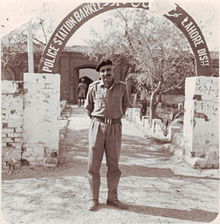 Lt. Col. Hari Singh of the India's 18th Cavalry posing outside a captured Pakistani police station (Barkee) in Lahore District.
Lt. Col. Hari Singh of the India's 18th Cavalry posing outside a captured Pakistani police station (Barkee) in Lahore District.
The second Indo-Pak war was also fought over Kashmir conflict. It ended in overall stalemate, with each of India and Pakistan capturing some territory from the other. Nonetheless, India was perceived as the victor due to its success in halting the Pakistan-backed insurgency in Kashmir. In its October 1965 issue, TIME quoted a Western official assessing the consequences of the war: "Now it's apparent to everybody that India is going to emerge as an Asian power in its own right."[citation needed]
While the overall performance of the Indian military was praised, military leaders were criticized for their failure to use India's superior numbers to exact a decisive victory over Pakistan. The Pakistani government was accused by foreign analysts of spreading disinformation among its citizens regarding the actual consequences of the war.[14] Most observers[who?] agree that the myth of a mobile, hard hitting Pakistan Army was badly dented in the war, as critical breakthroughs were not made.[citation needed]
Third Indo-Pak war, 1971
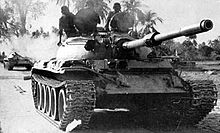 Indian T-55 tanks near Dhaka
Indian T-55 tanks near Dhaka Main article: Indo-Pakistani War of 1971
Main article: Indo-Pakistani War of 1971In the third Indo-Pak war, India intervened decisively in what was then East Pakistan. The proximate cause was the mass exodus of refugees to India following West Pakistani military action in East Pakistan, a conflict later called the Bangladesh Liberation War. India succeeded in removing Pakistani soldiers from the area, capturing 97,000 Pakistani POWs in the process. Following the war, East Pakistan became the independent nation of Bangladesh.
This is often cited as India's greatest military victory in its 5,000-year history. Bangladesh claims a huge genocide committed by the Pakistani Army, with figures of as much as three million killed often agreed upon.[citation needed]
Siachen War, 1984
Main article: Siachen conflictIn the late 1970s and early 1980s, Pakistan began organising tourist expeditions the Siachen Glacier, disputed territory with India. Irked by this development, in April 1984 India mounted Operation Meghdoot, capturing the top of the Glacier. It still maintains a military base there.[15] Pakistan on the other hand spends just under US$1 million per day, though as % of GDP Pakistan spends 5 times as the Indian Military does to maintain its share of the glacier.[16] Pakistan tried in 1987 and in 1989 to re-take the glacier but was unsuccessful. A stalemate has arisen: India controls the top part of the glacier and Pakistan controls the bottom.
Kargil war, 1999, Operation VIJAY
India fought a brief border skirmish with Pakistan in Kashmir in 1999. Dubbed the Kargil War, after the infiltration of Pakistani soldiers and paramilitary in the Kargil area, India recaptured most of the territory using specialized high-altitude infantry units, heavy artillery, and close air support. Pakistan retreated from all but a few of the remaining bases occupied by them. Following international diplomatic pressure, Pakistan vacated the remaining posts as well.
Other operations
The Chola incident, 1967
A Sino-Indian skirmish known today as the Chola incident took place in October 1967. The People's Liberation Army made a brief incursion into Sikkim but retreated within 48 hours.
Operation Blue Star, 1984
Main article: Operation Blue StarIn June 1984, then-Prime Minister Indira Gandhi ordered an attack on Sikh separatists belonging to the Khalistan movement who had holed up in the Golden Temple in Amritsar. The operation resulted in 500-1,500 civilian deaths and heavy damage to the Akal Takht.
Sri Lanka mission, 1987–1990
Main article: Sri Lankan Civil War#Indian involvementThe Indian Peace Keeping Force (IPKF) carried out a mission in northern and eastern Sri Lanka in 1987–1990 to disarm the Tamil Tigers per the Indo-Sri Lanka Accord. It was a difficult battle for the Indian Army, which was not trained for an unconventional war. After losing approximately 1,200 in personnel and several T-72 tanks, India ultimately abandoned the mission in consultation with Sri Lankan government. In what was labeled as Operation Pawan, the Indian Air Force flew about 70,000 sorties to and within Sri Lanka.
Operation Cactus, 1988
An Indian Air Force Ilyushin Il-76 transport aircraft of the model used to paradrop Indian troops in Malé. Main article: Operation Cactus
Main article: Operation CactusIn November 1988, the Maldives Government appealed India for military help against a mercenary invasion. On the night of 3 November, the Indian Air Force airlifted a parachute battalion group from Agra and flew them non-stop over 2,000 km to Maldives. The paratroopers landed at Hulule, secured the airfield, and restored government rule at Malé within hours and without bloodshed.
Missile program
India has well developed[citation needed] missile capabilities with roots in the Indian Space Program. The Integrated Guided Missile Development Program (IGMDP) was formed in 1983 with the aim of achieving self-sufficiency in missile development and production. Presently it comprises six core missile programs:
- Agni ballistic missile
- Prithvi ballistic missile
- Akash surface-to-air missile
- Trishul surface-to-air missile
- Nag anti-tank guided missile
- Nirbhay cruise missile
Currently the DRDO is developing Surya, an advanced series of ICBM that the government reports would have a range of more than 10,000 km. This would put its range on par with advanced missiles in the United States, Russia, and Israel.[17] India is the fourth country in the world to develop a successful[citation needed] missile defence shield, the Indian Ballistic Missile Defense Program.
Nuclear program
In 1966, India declared that it could produce nuclear weapons within 18 months. In 1974, India tested a nuclear weapon with a yield of up to 15 kilotons. The test was codenamed Smiling Buddha. On 11 and 13 May 1998, India conducted a total of five underground nuclear tests and declared itself a nuclear state.
Overview and recent developments
The Indian military has the third most troops of any in the world after the U.S. and China. The paramilitary unit of the Republic of India is the world's largest paramilitary force at over one million strong. Eager to portray itself as a potential superpower, India began an intense phase of upgrading its armed forces in the late 1990s. India focuses on developing indigenous military equipment rather than relying on other countries for supplies. Most of the Indian naval ships and submarines, military armoured vehicles, missiles, and ammunition are indigenously designed and manufactured.
Military collaborations with other countries
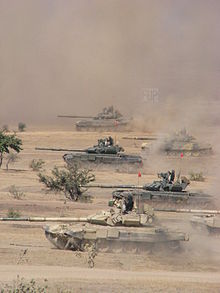 Indian T-90 Bhishma tanks during a training exercise in the Thar Desert, Rajasthan. Note the two different turret armour arrays.
Indian T-90 Bhishma tanks during a training exercise in the Thar Desert, Rajasthan. Note the two different turret armour arrays.
In 1997, India agreed to participate in the development of Russia's "Prospective Air Complex for Tactical Air Forces" program. One of the primary objectives of the program was to develop a 5th generation fighter aircraft; the Su-47 prototype flew its first successful test flight in 1997. The BrahMos, a supersonic cruise missile jointly developed with Russia, was successfully test fired in 2001. India is also collaborating with Israel to develop Unmanned Aerial Vehicles.
India has focused recently on purchasing the technology behind military equipment rather than equipment itself. Recent examples include purchases of Sukhoi Su-30 MKI multi-role fighter aircraft and T-90 main battle tanks from Russia and diesel-powered Scorpene submarines from France. In 2004, India purchased US$5.7 billion worth of military equipment from other countries, making it the developing world's leading arms purchaser.
Disasters
On 28 April 2000, ammunition worth
 393 crore (US$79.7 million) was destroyed in a fire at the Bharatpur ammunition depot. Another fire at the Pathankot sub-depot resulted in loss of ammo worth
393 crore (US$79.7 million) was destroyed in a fire at the Bharatpur ammunition depot. Another fire at the Pathankot sub-depot resulted in loss of ammo worth  28 crore (US$5.68 million). On 24 May 2001, another blaze at the Birdhwal sub-depot destroyed ammunition worth
28 crore (US$5.68 million). On 24 May 2001, another blaze at the Birdhwal sub-depot destroyed ammunition worth  378 crore (US$76.66 million).
378 crore (US$76.66 million).Awards
 The Ashoka Chakra
The Ashoka Chakra
India's highest awards for military conduct in a time of war are, in descending order, the Param Vir Chakra, Maha Vir Chakra, and Vir Chakra. The peacetime equivalents are respectively the Ashoka Chakra, Kirti Chakra and Shaurya Chakra. The latter two awards were formerly known as Ashoka Chakra, Class II and Ashoka Chakra, Class III respectively. The peacetime awards have occasionally been bestowed on civilians. For meritorious service, the awards are the Param Vishisht Seva Medal, the Athi Vishisht Seva Medal, and the Vishisht Seva Medal.
See also
- Military of India
- Military history of India during World War II
- History of the Indian Navy
- History of India
- History of Indian martial arts
External links
- The Irrelevance of India's Rise as a Military Power- video of lecture by Stephen P. Cohen, Brookings Institution, hosted by the Program in Arms Control, Disarmament, and International Security (ACDIS), University of Illinois, 15 October 2009
- Notes
- The Role of Muslims Martial Races of Today: Pakistan in British-Indian Army in World War-II by Brig (Retd) Noor A Husain.
- India Defence- Defence And Military Portal
- Indian Jawan- A Tribute To The Indian Soldier
- Indian army history
- Indian Air Force history
- Indian Air Force History (Bharat-Rakshak.com)
- Soldiers of the British and Indian armies 1840 to 1920
- Anne S. K. Brown Military Collection, Brown University Library Military history and graphics, circa 1790–1918
Official war histories
Official war histories written by the History Division, Ministry of Defence, Government of India:
Notes
- ^ http://www.history-of-india.net/mahajanapadas.htm
- ^ The Cambridge history of the British Empire, Volume 2 by Arthur Percival Newton p.14
- ^ http://sun.menloschool.org/~sportman/westernstudies/first/1718/2000/eblock/mughal/
- ^ John F Richards, The Mughal Empire, Vol I.5, New Cambridge History of India, Cambridge University Press, 1996
- ^ [1]
- ^ [2]
- ^ "Missiles mainstay of Pak's N-arsenal". The Times of India. http://articles.timesofindia.indiatimes.com/2008-04-21/india/27784965_1_cruise-missile-missile-program-hatf-viii. Retrieved 30 August 2011.
- ^ "Rockets: History and Theory". White Sands Missile Range. Archived from the original on 8 February 2008. http://web.archive.org/web/20080208121415/http://www.wsmr.army.mil/pao/FactSheets/rkhist.htm. Retrieved 30 August 2011.
- ^ Pati, p.31
- ^ Participants from the Indian subcontinent in the First World War. Memorial Gates Trust. http://www.mgtrust.org/ind1.htm. Retrieved 2009-09-12.
- ^ Commonwealth War Graves Commission Annual Report 2007–2008 Online
- ^ Sumner, p.7
- ^ http://www.goacom.com/culture/history/history4.html
- ^ [3]
- ^ Easen, Nick (20 May 2002). "Siachen: The world's highest cold war". CNN. http://edition.cnn.com/2002/WORLD/asiapcf/south/05/20/siachen.kashmir/. Retrieved 2006-04-10.
- ^ , Cost of Conflict Between India and Pakistan, ISBN 81-88262-05-6
- ^ "Development of Ballistic Missile Defence System: Year End Review" (Press release). Ministry of Defence (India). 28 December 2007. http://pib.nic.in/release/release.asp?relid=34262. Retrieved 2008-01-26.
Military history of Asia Sovereign
states- Afghanistan
- Armenia
- Azerbaijan
- Bahrain
- Bangladesh
- Bhutan
- Brunei
- Burma (Myanmar)
- Cambodia
- People's Republic of China
- Cyprus
- East Timor (Timor-Leste)
- Egypt
- Georgia
- India
- Indonesia
- Iran
- Iraq
- Israel
- Japan
- Jordan
- Kazakhstan
- North Korea
- South Korea
- Kuwait
- Kyrgyzstan
- Laos
- Lebanon
- Malaysia
- Maldives
- Mongolia
- Nepal
- Oman
- Pakistan
- Philippines
- Qatar
- Russia
- Saudi Arabia
- Singapore
- Sri Lanka
- Syria
- Tajikistan
- Thailand
- Turkey
- Turkmenistan
- United Arab Emirates
- Uzbekistan
- Vietnam
- Yemen
States with limited
recognition- Abkhazia
- Nagorno-Karabakh
- Northern Cyprus
- Palestine
- Republic of China (Taiwan)
- South Ossetia
Dependencies and
other territories- Christmas Island
- Cocos (Keeling) Islands
- Hong Kong
- Macau
Categories:
Wikimedia Foundation. 2010.

